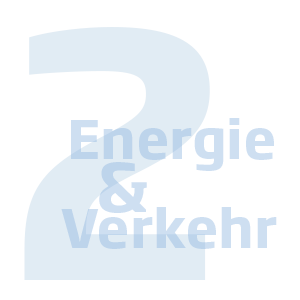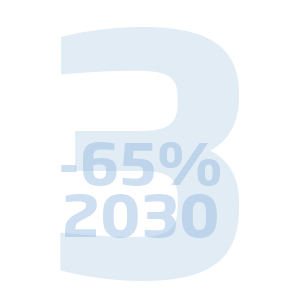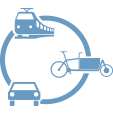Shaping new mobility efficiently and intelligently
Political demands of the BEM
Policies in Germany for environmental protection in society, the economy and mobility fall short of their potential. The majority of actors across the political spectrum are in favour of greater compatibility between the requirements of modern industrial societies and the need to preserve and care for the environment. As a result, however, Germany achieves at best a middling result in terms of actual implementation.
Politics in Germany is not setting the pace for reform. Previous decisions in transport policy have neither led to a reduction in the climate impact of our mobility nor triggered a change in social behaviour. Changes are already failing due to a lack of concepts, a lack of detailed knowledge on the part of those responsible, a lack of interdisciplinary interfaces and a high level of interest on the part of administrative staff in maintaining tried-and-tested working methods and the usual framework of influence by maintaining existing contacts, relationships and advisors.
The Bundesverband eMobilität e.V. (BEM) has been promoting electric mobility based on renewable energies as the most efficient drive solution for 15 years. With the help of political decisions already taken in Brussels and the tentative, initial beginnings of reform in German road transport, the BEM believes that the groundwork has been laid to restructure transport policy efficiently and intelligently and to reorganise the New Mobility in a meaningful way with fresh forces.
The following recommendations of the Bundesverband eMobilität are based on the technical advice of the BEM working groups, which work openly and differentiated according to individual topics and include the knowledge and expertise of relevant pioneering companies in electromobility. It is not uncommon for them to belong to the reform wing of the German SME sector, for whom feasibility and affordability are a matter close to their hearts. They are all united by the awareness that new technologies and smart connections form the basis for creating jobs and added value and for combining prosperity and environmental protection.
Creating more clarity in politics and legislation
The BEM urgently recommends a separate legal framework for electromobility and a new specialist organisation with appropriate experts.

To date, electromobility has been an unloved additional topic in the ministries’ areas of responsibility.
There are neither interdepartmental working groups in the federal ministries nor a separate legal framework.
Status Quo
- 25 different laws, regulations and ordinances from various ministries govern the eMobility sector
- Various, sometimes contradictory third-party laws
- technical support and advice is the responsibility of a federal organisation that was originally responsible for hydrogen
Electric Mobility Act (EmoG)
• only 8 paragraphs
• without a clear legal mandate
• does not cover all eMobiles
• expires in 2026
1. Create more clarity in politics & legislation

Building in more acceptance for interoperable systems
The transport transition is largely dependent on energy supply issues. Systems, technologies and organisations must be enabled to cooperate and connect with each other.
- Exempt all CO2-free energy sources from the EEG levy
- Consider the potential of mobile storage systems through charging and discharging compared to stationary storage systems

Charging infrastructure
- Standardise charging infrastructure
- Drive-through DC charging points
- Enable network operators to make charging infrastructure affordable
- Operation should be subject to the free market economy
- Speed up bureaucratic processes

The battery
- Produce and recycle batteries regionally
- Introduce a transparency register for raw materials
- Ensure general humanitarian compatibility

Security
- Personnel qualification
- Training and generating new skilled labour
- Establishing new safety standards for transport, rescue, recovery and construction
- Cybersecurity and interoperable systems, utilisation of the Mobility Data Space area
2. Building more acceptance for interoperable systems
Realise consistent implementation
If you want to reduce greenhouse gases, you have to make decisions and agree on measures.


Maritime sector
- Favour or promote the purchase of electrically powered watercraft or conversion to e-drive in the same way as for road transport

Lightweight vehicles
- Promote classes L1e-L7e
- Adjust maximum speed to 59 km/h

eAviation
- Promote with research and development funds

Construction, agricultural and special machinery
- Acquisition and conversion analogous to other conversion programmes
- Link public tenders to zero-emission requirements
- 2-stroke engine registration ban from 2024
Plug-in hybrids for cars are merely a bridging solution
The BEM has presented a three-stage model for the reform of the PHEV vehicle subsidy: Stagger the payment of the environmental bonus and stagger it according to environmental impact; push the use of vehicles as e-cars and reward actual gains in positive environmental impact.
3. Realise consistent implementation

Remove bullshit
Funding programmes for combustion vehicles must be stopped.
All privileges and benefits for the combustion engine must be discontinued immediately.
Germany does not recognise its own real electromobility. There is a lack of data collection and official recording. Calculations provide a blind flight into the future.

Federal Motor Transport Authority
- Record battery capacities, storage potential, energy requirements, load and demand peaks of e-vehicles on the market

eTrailer
- Use enables considerable CO2 savings, but the Federal Ministry of Transport does not recognise any environmental effect

With an expiry date of 31 December 2026, the current Electric Mobility Act does not provide any perspective.
Electric mobility players have no legal certainty in Germany, which urgently needs to be changed.
Every day without a concept weakens companies ready for reform. Mobility companies need planning and investment security.
4. Remove bullshit
Simple & digital expansion
The electromobility system requires networked players and faster action, which can be achieved with the help of digitalisation.
The BEM is urgently calling for the creation of digital identities in order to standardise basic processes in the vehicle trade and allow for new business models.

Germany does not recognise its own real electromobility. There is a lack of data collection and official recording. Calculations provide a blind flight into the future.

Use of data
- Create standards that are in line with European data protection
- Operate on platforms that are accessible to all interested parties and provide the right interfaces
- Devices must be able to communicate with each other

At this interface, it will then be all the easier to combine different forms of transport and promote intermodality in cities and the countryside.

Speeding limit
The BEM supports the calls for a speed limit of 130 km/h and welcomes the scientific promotion of AI projects, especially in the mobility transition.
